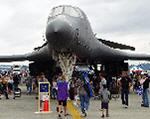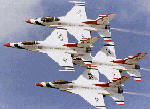
|
Description
| Manufacturer: | Northrop | |
| Base model: | P-79 | |
| Designation: | XP-79 | |
| Version: | B | |
| Designation System: | U.S. Air Force | |
| Designation Period: | 1925-1947 | |
| Basic role: | Pursuit | |
| Status: | Experimental | |
Specifications
| Length: | 14 | ||
| Height: | 7 | ||
| Wingspan: | 38 | ||
| Wingarea: | 278.0 sq ft | 25.8 sq m | |
| Gross Weight: | 8,669 lb | 3,931 kg | |
Propulsion
| No. of Engines: | 2 | ||
| Powerplant: | Westinghouse 19-B | ||
Performance
| Range: | 993 miles | 1,599 km | |
| Cruise Speed: | 480 mph | 772 km/h | 417 kt |
| Max Speed: | 547 mph | 880 km/h | 475 kt |
| Ceiling: | 40,000 ft | 12,191 m | |
Known serial numbers
Recent comments by our visitors
| wedding decoration , AZ | women's swimwear
women's trousers womens cardigans work gloves earrings boots hunter boots cowboy boots rain boots riding boots fleece trousers bottoms trousers bras strapless bra 06/24/2012 @ 23:38 [ref: 61994] |
| chat cairo, CA | Thank u so much
شات الحب تحميل مهرجانات دردشه الحب ديكورات جديدة دردشه مصريه اغاني سنجل حديثة دردشة الحب رسائل حب شات مصريه تحميل مسلسلات رمضان 2012 شات مصرية يوتيوب دردشة مصر مشاهدة اون لاين دردشه مصرى تحميل افلام عربي دردشة مصرى صور حب دردشه الشله صور رومانسية شات الشله صور الفنانين شات مصرى صور اسلامية شات بنات اخر نكته دردشه مصر مركز رفع الصور دردشة مصرية برامج الكمبيوتر شات مصر ماسنجر دردشة مقياس الحب دردشة نهر الحب ازياء 2012 دردشة بنات لبنان راديو مزيكا دردشه نهر الحب فوتوشوب دردشه بنات لبنان العاب الكمبيوتر شات نهر الحب تعليم الطبخ شات ادما ديكور 2012 شات بنات لبنان ثيمات مسن 2012 فساتين سهره دردشة الحلم العربي mazika زخرفه شات دردشة ادما توبيكات مسن Chat girls مجلة مزيكا رمزيات ماسنجر دردشة بنت السعودية منتدي دردشه بنت السعوديه العاب بنات شات بنت السعوديه زخرفة انجلش دردشة شقاوة شات الحلم العربي تطوير المواقع دردشه شقاوه طبختك دردشه الحلم العربي صور مسن شات شقاوه sitemap زخرفه انجلش rss2 زخارف انجلش مزيكا فساتين سهرة جنان Code of Arab دردشه حبنا صور الفنانين دردشة حبنا بدل رجالي 2012 اضف موقعك دردشه العنابى اغاني شعبي دردشة السعودية اخبار مصر دردشة الشلة زخارف شات بنات السعودية صور حزينة دردشه ادما Romantic Wallpapers شات الثقافة الجنسية شات حبنا دليل بنات مزيكا دردشة بنات مزيكا منتديات بنات مزيكا دردشة العنابى منتدي الصور واللقطات chat egyptian صور رومانسية 2012 فضائح الفنانين صور الفنانين والمشاهير 2012 صور بنات 2012 صور شباب 2012 عالم حواء شات العنابى ازياء 2012 مكياج 2012 حوامل - ازياء حوامل - فساتين حوامل - ملابس حوامل ازياء محجبات - فساتين محجبات - ملابس محجبات - صور ازياء فساتين محجبات 2012 فساتين سهره 2012 فساتين زفاف 2012 - فساتين عرايس - فساتين خطوبة زواج صور حب 2012 صور بنات جميلة 2012 صور بوس ساخنه 2012 06/24/2012 @ 05:33 [ref: 61583] |
| Matt Scotia, NY | The XP-79B, despite repeated claims to the contrary, was never intended to ram enemy aircraft. Four 50 cal.
Browning machine guns were the intended weapons. The headfirst pilot position makes any thought of a ramming attack suicidal. The leading edge wing armor was a holdover from the rocket-powered XP-79, and was intended to protect the fuel tanks. 02/21/2009 @ 16:22 [ref: 23789] |
| Michael Priester Jonesboro, GA | In the late stages of World War II, American bomber formations over Germany were occasionally attacked by a small, rocket-powered interceptor, the Messerschmitt Me-163 Komet. Fast as the Me-163s were, however, they were usually more spectacular than effective. Nevertheless, American aircrews must have marveled at the technology behind such an advanced-looking weapon - unaware that since 1942, something similar had been secretly under development in their own country.
The fighter that eventually became the Northrop XP-79B had an astonishing parallel development to the Me-163. It began in 1942 as a rocket-powered flying wing, but, in contrast to the Me-163, the American design was later adapted for jet power. Another difference between the XP-79B and its distant German cousin lay in their methods of attack. The Me-163 was meant to defend a faltering Third Reich with wing-mounted 30mm cannons or unguided rockets. The XP-79B's main means of downing its adversaries is best expressed in its nickname - Flying Ram. Jack Northrop designed numerous advanced aircraft of conventional configuration, but he was fascinated by the flying-wing concept. He believed that such a pure airfoil surface would have the most efficient lifting capabilities. Also, the absence of a fuselage and tail unit would mean less drag to affect overall performance - as well as lower production costs. Northrop's flying-wing concept took a dramatic step forward in 1942, when he convinced the U.S. Army Air Forces (USAAF) that he could build a fighter that could reach the speed of sound. Beneath the USAAF-classified wraps, "Project 12," as the design was designated, was a rocket-powered flying wing with a wingspan of only 32 feet. The pilot was to fly it in a prone position, the rationale being that such a posture would make him less vulnerable to G-forces and raise his "blackout threshold" beyond normal human limits. Essentially, the XP-79 was an interceptor that would bring down its opponents by ramming them in flight. During the early months of the German invasion of Russia in 1941 and 1942, Russian fighter pilots had frequently resorted to various taran, or midair ramming techniques. There was no real need for American fighter pilots to resort to such tactics, however, and the USAAF officer who came up with the idea for the ram fighter may be grateful that his identity is lost to history. In any case, in January 1943, Northrop was awarded a contract to build three XP-79 Flying Ram prototypes, each of which was to be powered by an Aerojet rocket engine with 2,000 pounds of thrust. A plague of developmental problems with the proposed Aerojet engine, and the unlikelihood of its being able to keep the plane airborne for more than 30 minutes, led the USAAF to cancel its order for the rockets and for two of the XP-79s that were to be powered by them. The Army did, however, consent to completion of the third prototype, which used two Westinghouse 19B axial-flow jet engines with 1,345 pounds of thrust each. The jet-engine revision, designated the XP-79B, weighed 5,840 pounds empty and 8,669 pounds with a full operational load. Like its rocket-powered precursor, the jet-powered XP-79B was essentially a wing, with the pilot lying on his stomach between the two jet engines. His head protruded into an acrylic-plastic windshield fitted with an armor glass section. An overhead hatch gave him entry to and, if necessary, a hasty exit from the cabin. As radical as the XP-79's all-wing configuration looked, its structure was equally unusual. The airframe was made of heavy-gauge magnesium. The leading-edge skin was three-fourths of an inch thick; reinforcing steel armor plate of one-fourth-inch thickness was heliarc-welded at a 45-degree angle just inside the wing's leading edge. Upon receiving reports of approaching enemy bombers, the XP-79B was intended to take off with the aid of JATO (jet-assisted takeoff) packs at an estimated rate of 25,000 feet in 4.7 minutes. Reaching an altitude of 40,000 feet, the Flying Ram would then dive into the formation of enemy aircraft at an estimated speed of up to 547 mph and clip their wing or tail surfaces with its own reinforced wings. Even among the USAAF brass, someone must have recognized the absurdity of that idea, because the XP-79B order also stipulated that the fighter should accommodate four .50-caliber Browning machine guns outboard of the jet engines. Neither the guns nor the cockpit pressurization system (allowing the pilot to function at 40,000 feet) were destined to be installed in the plane. Painted white overall, and given the serial number 43-32437, the prototype XP-79B was covered with canvas and trucked to the Muroc Dry Lake testing facility. Its first taxiing tests were conducted in June 1945 - during which its tires burst on several occasions. Finally, on September 12, 1945, Harry Crosby prepared to take the XP-79B up for its maiden flight - and almost ran into disaster before he got off the ground. As the plane accelerated down the runway, an Army firetruck pulled out directly in its path. Crosby chopped the throttle but then applied power again as the truck got out of his way. Taking off without further incident, Crosby climbed to 10,000 feet. During the next 15 minutes, he flew back and forth over the field, testing the exotic plane's ability to turn. Things suddenly went wrong during one such turn, and degenerated into a nose-down spin. After a brave but futile effort, Crosby finally judged it impossible to regain control of the plane. Jettisoning the escape hatch, he tried to leap clear - only to be struck by the wildly gyrating wing. Crosby fell to his death, his parachute unopened. The XP-79B slammed into the desert floor and exploded in a white-hot flare of magnesium that consumed the entire plane. Northrop's engineers determined that the control problem that had cost Harry Crosby his life could be corrected, but the USAAF decided to abandon the XP-79B project. World War II was over, the Lockheed P-80 Shooting Star was entering production, and other, more conventional jet designs were showing greater promise than the flying-ram concept. The techniques involved in the production of the XP-79B would later help in the development and mass production of the ultimate realization of Jack Northrop's flying-wing dream - his giant B-35 and B-49 bombers. 08/08/2007 @ 04:30 [ref: 17515] |
| Terry Richmond, VA | I have recently had the pleasure of adding the XP79B to a WWII flight sim as part of an add on. The site for the add on can be found at http://www.b-dod.com/ldor/ In the plane list select P79B. The click on "View Newsreel" to see how it may have worked in combat.
The flight sim is "physics based" and can be extremely accurate in its fligth model. Its hard to make something fly that wouldnt have with out a lot of fudging. We didnt fudge at all. I have pulled 18G maneuvers (like to see any fighter stick with me...;) It would have ben better had Northrop Grumman answered my requests for information, but we seem to have done well... Thanks for the site... Good work 04/02/2004 @ 08:39 [ref: 7130] |
Recent photos uploaded by our visitors





